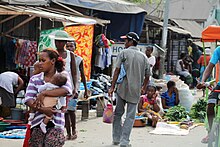Sakalava

Sakalava people near Morondava
|
|
| Total population | |
|---|---|
| (c. 1,200,000) | |
| Regions with significant populations | |
| Madagascar | |
| Languages | |
| Malagasy | |
| Religion | |
| Christianity (Catholicism, commoners), Fomba Gasy (traditional religion), Islam (royalty) | |
| Related ethnic groups | |
| Other Malagasy groups, Austronesian peoples |
The Sakalava are an ethnic group of Madagascar. They are found on the western and northwest region of the island, in a band along the coast. The Sakalava are one of the smaller ethnic groups, constituting about 6.2 percent of the total population, that is over 1,210,000 in 2014. Their name means "people of the long valleys." They occupy the western edge of the island from Toliara in the south to Sambirano in the north.
The Sakalava denominate a number of smaller ethnic groups that once comprised an empire, rather than an ethnic group in its own right. The origin of the word Sakalava itself is still subject to controversy, as well as its actual meaning. The most common explanation is the modern Malagasy translation of Sakalava meaning long ravines, denoting the relatively flat nature of the land in western Madagascar. Another theory is that the word is possibly from the Arabic saqaliba, which is in turn derived from Late Latin sclavus, meaning slave.
Austronesian people started settling in Madagascar between 200 and 500 CE. They arrived by boats and were from various southeast Asian groups. Later Swahili-Arabs and Indian traders came to the island's northern regions. African slaves were brought to the island in increasing numbers between the 15th and the 18th centuries, particularly to the region where Sakalava people now live. This influx of diverse people led to various Malagasy sub-ethnicities in the mid-2nd millennium. The Portuguese traders were the first Europeans to arrive in the 15th century, followed by other European powers.
The founder of Sakalava legacy was 15th century Andriamisara. His descendant Andriandahifotsy ("the White Prince"), after 1610, then extended his authority northwards, past the Mangoky River, aided by weapons obtained in exchange for slave trading. His two sons, Andriamanetiarivo and Andriamandisoarivo (also known as Tsimanatona) extended gains further up to the Tsongay region (now Mahajanga).
The chiefs of the different coastal settlements on the island began to extend their power to control trade. The first significant Sakalava kingdoms were formed about the 1650s. They dominated the western of northwestern regions of Madagascar during the 1700s. The Sakalava chiefdoms of the Menabe, centred in what was then known as Andakabe, now the town of Morondava, were principal among them. The influence of the Sakalava extended across what is now the provinces of Antsiranana, Mahajanga and Toliara. The Sakalava kingdom reached its peak geographic spread between 1730-1760, under King Andrianinevenarivo.
...
Wikipedia
